ATENDIMENTO ODONTOLÓGICO AO PACIENTE PORTADOR DE HEMOFILIA C: QUAIS SÃO CUIDADOS NECESSÁRIOS PARA UM CORRETO ATENDIMENTO? – REVISÃO DE LITERATURA
DOI:
https://doi.org/10.22409/ijosd.v1i51.36598Resumo
RESUMOA hemofilia é uma doença hemorrágica hemofilia hereditária ligada ao cromossomo X, caracterizada pela deficiência ou anormalidade da atividade coagulante do fator VIII (hemofilia A), do fator IX (B) ou mesmo do fator XI (hemofilia C). Esta doença é causada pela deficiência quantitativas dos fatores de coagulação, podendo causar sangramento espontâneo ou mesmo induzido por cirurgia ou trauma. A hemofilia C foi descrita em 1953, após vários membros de famílias de descendentes judaica (judeus Ashkenazi, descendentes de judeus que abandonaram Jerusalém e migraram para a Polônia e Báltico durante o primeiro século), terem surgidos com hemorragias excessiva ao serem submetidos a amigdalatomia e exodontias. A deficiência deste fator, é hereditária, resultante de uma mutação em um gene autossômico recessivo presente no cromossomo 4. Embora o diagnostico precoce seja de difícil execução, pois o paciente não apresenta sangramento espontâneo como em outros hemofilia, uma rigorosa anamnese deve ser realizada para que se possa tomar todas as medidas preventivas, evitando possíveis riscos ao paciente. O objetivo deste trabalho é realizar uma revisão de literatura sobre os cuidados necessários que o cirurgião – dentista deve ter frente a um paciente portador de hemofilia C. Para que o mesmo possa indicar e realizar corretamente o tratamento odontológico e evite possíveis riscos.
Palavras-chaves: Hemofilia; Hemofilia C; Atendimento odontológico; Fator XI.
ABSTRACT
Hemophilia is a hereditary hemorrhagic disease linked to the X chromosome, characterized by the deficiency or abnormality of factor VIII (hemophilia A), factor IX (hemophilia B) or even factor XI (hemophilia C) factor VIII coagulant activity. This disease is caused by the quantitative deficiency of coagulation factors, which can cause spontaneous bleeding or even induced by surgery or trauma. Haemophilia C was described in 1953 after several members of families of Jewish descent (Ashkenazi Jews, descendants of Jews who left Jerusalem and migrated to Poland and the Baltic during the first century), have arisen with excessive hemorrhages when undergoing tonsilatomy and Exodontia. The deficiency of this factor is hereditary, resulting from a mutation in an autosomal recessive gene present in chromosome 4. Although the early diagnosis is difficult to perform, since the patient does not present spontaneous bleeding as in other haemophilia, a rigorous anamnesis should be performed for That all preventive measures can be taken, avoiding possible risks to the patient. The objective of this work is to carry out a review of the literature on the necessary care that the dental surgeon must have in front of a patient with hemophilia C. In order that he may indicate and correctly perform the dental treatment and avoid possible risks.
Key words: Hemophilia; Hemophilia C; Dental care; Fact


